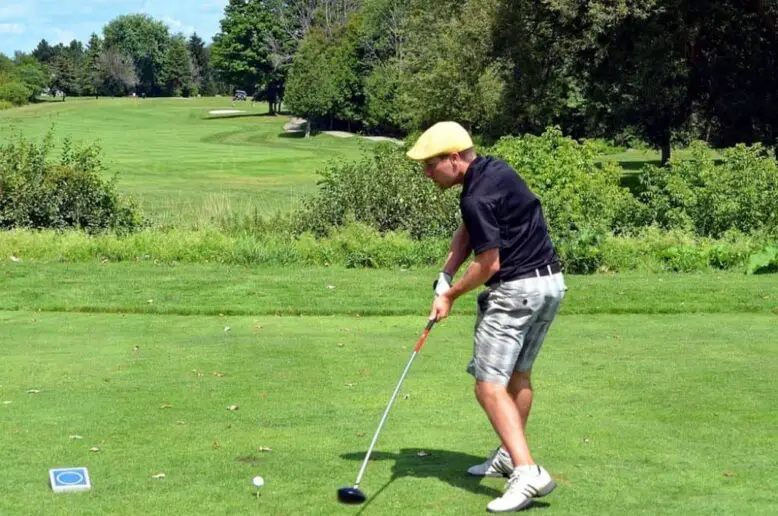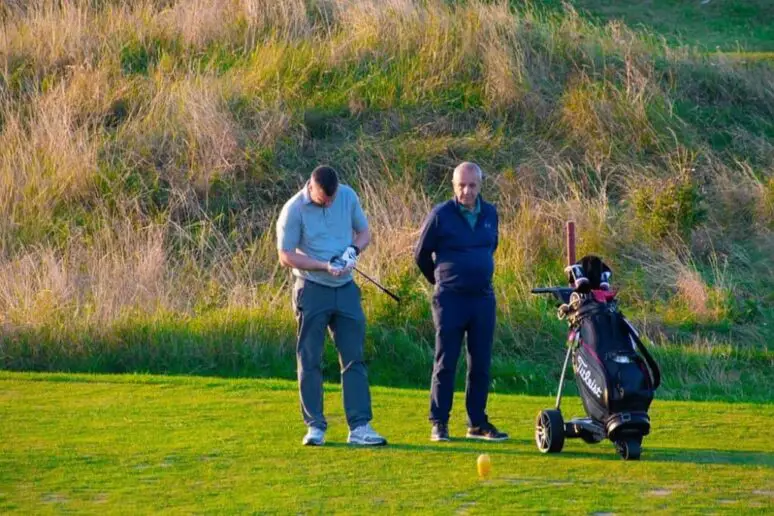Average Golf Handicap by Age – An Overview
One of the first things mentioned in the conversation among golfers or potential playing partners is the handicap of each player.
It’s also usually the starting point of setting up any golfing match.
Handicapping is the main reason why a less skilled player can go against an expert golfer on the course and still make it a fair fight.
It creates a level playing ground among players of different skill levels.
Another great thing about golf handicap is that it allows you to get a realistic picture of how worse or better you are than an average golfer, at least in your own age group.
To help you learn how you measure up against fellow golfers, I’ll detail the average golf handicap by age below.
However, many golfers, especially those new to the game, don’t fully grasp the golf handicaps.
So at the end of this article I will explain the basics of the handicap system.
Table of Contents
Average Handicap by Age
You may think that the average handicap numbers are dropping with modern equipment, better courses, and all the new tech available to players.
However, that’s not the case. The averages by age have seen little historical change over the last quarter of a century.
There are several reasons for this. One of them is that more and more casual golfers are registering the official handicap.
In addition, many older, but inexperienced, players join the golf clubs as they retire from the workforce.
A longer lifespan in modern society means that golf can be played later in life which leads to increased handicaps among 70 and 80-years old.
Plus, the handicap limits are now higher.
All these factors work together to keep the average handicaps by age at a constant level.
Current Average Handicaps by Age
Now it’s time to check the actual figures.
I’ll use data from only three countries that provide the most reliable information on handicapping: USA, UK, and Australia.
Still, the numbers from these three countries paint a pretty realistic picture of the handicap by age around the world.
First, we’ll look at the average score on a par 72 golf course by age among the players who regularly record and report their scores.
Be aware that, as many golfers don’t report their scores, the actual numbers may be a bit higher.
| Age In Years | Average Score On A Par 72 Course |
| 20-30 | 90 |
| 30-40 | 92 |
| 40-50 | 92 |
| 50-60 | 91 |
| 60+ | 92 |
| All Ages | 91 |
Besides age groups, handicaps also differ between male, female, and junior players, so we’ll look at the averages for each group.
Average Handicap by Age Among Male Players
Only around 2% of male players have their handicap at scratch or better and 90% of this group is in the 16-35 age bracket.
Around 30% of male players have their handicap in single figures.
While most of them are again among the younger player, there’s still a significant number of single-figure handicap players in the 35-50 age bracket.
After 50 years of age, this number drastically reduces and only rare golfers have a single-figure handicap beyond 60 years of age.
Players with handicaps in the 10-15 range make up around 30% of all male golfers. This level of handicap is rather evenly distributed across all age groups.
Average Handicap by Age Among Female Players
In general, ladies have much higher handicaps than their male counterparts.
Only around 4% of female players have a handicap in single figures. The majority, around 70% have a handicap of 21 or higher.
Average Handicap by Age Among Junior Players
The large majority of players in the junior bracket are absolute beginners and many of them play golf just for fun.
This means that their average handicaps are going to be much higher than in the other two groups.
Players in the 7-12 age group, in most cases, don’t register handicaps yet, but their average score is around 150.
A bit older golfers, ages 11-16, register a handicap average of 24.
What is Golf Handicap?

In the simplest of terms, a handicap is a numerical value assigned to each golfer based on their previous performances.
It’s based on the score and it will commonly show how many strokes over the par the player will take.
A par, for those who don’t know, is a neutral score, for example, five strokes to complete a par 5 hole.
As a player gets better and his skill level improves, the handicap will typically decrease.
After years of practice, once you become capable of making a par or less on the course, you may achieve a zero handicap and be considered a scratch golfer.
It’s important to note that making par can vary from course to course, so the course difficulty rating is also taken into account.
Even though the golfer’s honesty is still a substantial factor, the handicapping system has significantly developed and changed over the years, but more on that later.
Why Does the Handicap System Exist?
The idea behind the golf handicaps is to provide a relatively level playing field for golfers of different abilities, skills, and experience.
Like many things in golf, it’s built on honesty and trust, but, for the most part, the system seems to work.
Even though the handicapping rules are somewhat complex, the important thing is that they’re consistent across the sport and equally applied to all the players, no matter their status.
How to Get a Handicap?
Getting a handicap in golf is rather simple, at least nowadays. Until recently, only verified members of golf clubs were able to get the official handicap.
Casual golfers who weren’t affiliated with any club were denied that opportunity. In recent years, this has changed.
Golf club membership still commonly means that you get your golf handicap, usually for a small fee.
However, now you can also sign up for handicap by registering yourself.
In the United States, getting your handicap index is as simple as joining the USGA community near you or registering online.
The registration fee is rarely higher than $30-40 per year. The USGA has led the way, but other national golf organizations across the globe are quickly joining in.
The new system permitting beginners to get handicapped allows us to have more precise information on the main topic of this article, the average handicap by age.
How Golf Handicap Works?
Golfers that are club members already and have an official handicap commonly have a good understanding of how handicapping works.
They’re mostly aware that they have to play and shoot well to keep up with their handicap.
However, the common belief among casual golfers is that average play is enough to shoot the handicap.
What they mostly forget is that only the best 8 scores from 20 rounds account for the handicap.
The other 12 are disregarded and don’t impact the handicap. So, the handicap is not the average of your score.
Still, many casual golfers are yet to play 20 rounds so their handicap can be properly adjusted. However, as they play golf more regularly, these issues will likely be self-corrected.
With three million casual golfers already registered with an official handicap, there’s plenty of reliable data to take them into account when figuring out the average handicap by age.
Factors that Impact the Average Golf Handicap by Age

World Handicap System (WHS)
The most significant development in golf handicapping happened in 2020 when the World Handicap System was launched.
The system was developed in an effort to provide players with a standardized and unified system of handicapping that would be more inclusive and the same no matter where you play your golf.
It brought an end to the situation where various handicapping systems were used in different parts of the world.
Before WHS was created, there were 6 different ways of handicapping in use.
The existence of the World Handicap system means that golfers of different skill levels can now compete on equal playing ground on any course and in any format anywhere in the world.
Furthermore, the new system is much easier to understand and implement, without losing any of accuracy.
The WHS answers the diverse needs and expectations of players and golfing organizations and clubs no matter their golf cultural background.
Current Handicapping Trends in the World
The emergence of WHS has provided us with more insight into ongoing trends in the world of golf, especially considering the scoring and handicaps.
While not all countries have this data readily available, the information for the leading golfing nations, USA and UK, can give us a pretty clear picture of the current state of affairs.
Currently, there are 18 million golfers in the United States. More than half, or 11.5 million (64%) are casual golfers, while 6.5 million (36%) are golf club members.
More than 50% of the total number of golfers have an official golf handicap, but only around 3 million (24%) casual golfers.
The structure of golfers is similar in the UK, with 2 million golfers in total and 60/40 split between casual golfers and club members.
However, while 42% of club members play with a handicap, only 3% of casual golfers are in this group.
The Significance of Global Handicapping Trends for the Average Golf Handicap by Age
Among the number of casual golfers detailed above, around 10% are first-time players or beginners.
On the other hand, seniors are the biggest group among the new club members.
The explanation for this is fairly simple, these are retirees who finally have some free time to dedicate to golfing.
Also, with the increased role of social media and more media coverage of golf competitions, more and more kids and young people are taking up golf, increasing the numbers in the junior bracket.
In addition, golf is now more of a global game and new markets bring millions and millions of new players.
Plus, people now live longer and 80-year-olds on the golf course are no longer a rarity,
This huge intake of new players and older ones who, naturally, have difficulties maintaining low handicaps, is an important factor that has a great impact on average handicaps in all age groups.
New Maximum Handicaps
Besides the overhaul of the entire system, modern handicapping also features increased handicap allocations or limits.
They’re significantly higher compared to 20 years ago when the maximum official handicap for male golfers was 28, for lady golfers 36, and 45 for players in the junior bracket.
Now, most golfing organizations around the world have set the handicap limits at 36 for male golfers (an 8 shots and almost 30% increase), 54 for ladies (up 18 shots or 50%), and also 54 for junior golfers (up 9 shots or 20%).
The new maximum should help players get a grasp of handicaps earlier in their golfing career, as with higher limits even absolute beginners can have an official handicap.
It can also serve as great motivation, as players can observe their handicap decrease as they improve their game.
Obviously, the new limits also contribute to the average handicap in different age groups.
Conclusion
As golf rapidly expands around the world and gains thousands of new players every day, the average handicaps by age are certainly going to be influenced by these developments.
The large number of older players who take up golf for the first time in their lives also has a huge bearing on these averages.
The positive thing is certain that most of these new players look to register golf handicaps and regularly record and report their scores.
This way, all golfers can enjoy a fair playing field and participate in competitive matches, even with golfers high above their skill level.




